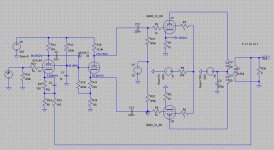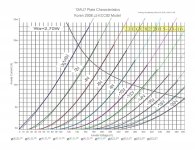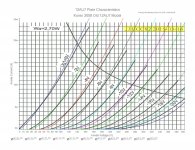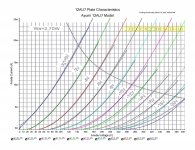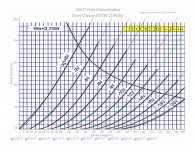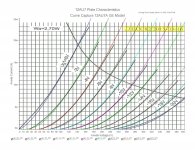I see, thanks for doing it.I have test results of the complete amplifier with 6F12P amplifier/cathodyne and GNFB.
Not only the output stage like you simulated.
Therefore I first have to "build" the same schematic as my amplifier is and simulate that with LTSpice.
I can hopefully do this today.
I finally got the simulations done.
I is a bit diffucult to know which differences come from OPT, output tubes and front end tube used with simulation vs. real components.
However I noticed some 2...3 dB higher overal gain in simulated circuit than in real circuit. (this without GNFB)
The above difference leads to higher GNFB than I have planned.
Power output was also a bit bigger, but adding some series resistances to OPT and power supply, the result is quite equal.
To 8 ohms max. Pout = 11.5 W and at 10 W the THD = 0.2 %
The power output at half load (4 ohms) seems same as with real circuit, i.e. max. Pout = 9 W with 0.9 % THD.
The standing current of output tube seems to be some 10 % bigger that with real circuit.
As a conclusion I would say that your QQE03/12 Spice model is quite accurate.
If you need my circuit as .asc I can provide that.
I is a bit diffucult to know which differences come from OPT, output tubes and front end tube used with simulation vs. real components.
However I noticed some 2...3 dB higher overal gain in simulated circuit than in real circuit. (this without GNFB)
The above difference leads to higher GNFB than I have planned.
Power output was also a bit bigger, but adding some series resistances to OPT and power supply, the result is quite equal.
To 8 ohms max. Pout = 11.5 W and at 10 W the THD = 0.2 %
The power output at half load (4 ohms) seems same as with real circuit, i.e. max. Pout = 9 W with 0.9 % THD.
The standing current of output tube seems to be some 10 % bigger that with real circuit.
As a conclusion I would say that your QQE03/12 Spice model is quite accurate.
If you need my circuit as .asc I can provide that.
Attachments
That's good to know, I also noticed an error in the sim that I posted above, I have asked the Mods to remove it to avoid confusion. Thanks again for verifying the model.As a conclusion I would say that your QQE03/12 Spice model is quite accurate.
Jazbo,
How did you go about getting it removed?
jmack
How did you go about getting it removed?
That's good to know, I also noticed an error in the sim that I posted above, I have asked the Mods to remove it to avoid confusion. Thanks again for verifying the model.
jmack
I sent the Mods a note using the small "Report Post" button located on the lower left corner of each post.How did you go about getting it removed?
Jazbo,
Thank you!
jmack
Thank you!
jmack
I sent the Mods a note using the small "Report Post" button located on the lower left corner of each post.
I recently built and tested a mu follower using a 12AU7 running at about 10mA and driving a 10K load. I simulated it using LTspice. Using the Koren model with 10V rms out into 10K load I get 0.2% THD. Using another model made from published curves using Curve Captor I get 0.7% under the same conditions. I tested 5 JJ ECC82 tubes in the circuit and each one measured close to 0.5% THD.
I was surprised the Koren model was so far from reality.
Cheers
Ian
I was surprised the Koren model was so far from reality.
Cheers
Ian
I was surprised the Koren model was so far from reality.
I often found Koren models to be very "benign". Somehow, the model appears to space out curves more evenly than they actually are, resulting in less distortion.
The other issue is with (almost) all curve models and ltspice as such, I found the predictive capability for distortions to be very limited.. H2 and H3 seem to be somehow accurate with good models and classic or hot operating points. With lower voltages, they usually deteriorate quickly and become just as bad in resolution as for the higher harmonics.
Usually, it makes no sense to tune operating points by fiddling around in ltspice. Determine operating points for lowest distortion by conventional wisdom.
Ian,
Koren’s JJ ECC82 model (http://www.vcu.edu/csbc/bnfo601/Paul_amp_designs/Koren_Tubes.inc) seems to match JJ’s latest published ECC82 data (http://www.jj-electronic.com/pdf/ECC 82.pdf) much better than the original Koren 12AU7 model and somewhat better than the Ayumi model (see attached images). If JJ’s data sheet accurately characterizes your tubes, you would likely get more accurate results using the Koren JJ model. I’d be happy to run that simulation (with Multisim) if you like. I’d also be happy to produce/share an overlay like those attached for your “Curve Captor” model.
What is “Curve Captor”?
jmack
Koren’s JJ ECC82 model (http://www.vcu.edu/csbc/bnfo601/Paul_amp_designs/Koren_Tubes.inc) seems to match JJ’s latest published ECC82 data (http://www.jj-electronic.com/pdf/ECC 82.pdf) much better than the original Koren 12AU7 model and somewhat better than the Ayumi model (see attached images). If JJ’s data sheet accurately characterizes your tubes, you would likely get more accurate results using the Koren JJ model. I’d be happy to run that simulation (with Multisim) if you like. I’d also be happy to produce/share an overlay like those attached for your “Curve Captor” model.
What is “Curve Captor”?
jmack
I recently built and tested a mu follower using a 12AU7 running at about 10mA and driving a 10K load. I simulated it using LTspice. Using the Koren model with 10V rms out into 10K load I get 0.2% THD. Using another model made from published curves using Curve Captor I get 0.7% under the same conditions. I tested 5 JJ ECC82 tubes in the circuit and each one measured close to 0.5% THD.
I was surprised the Koren model was so far from reality.
Cheers
Ian
Attachments
Ian,
What is “Curve Captor”?
jmack
http://www.diyaudio.com/forums/tube...be-modeling-software-beta-testers-wanted.html
Here's one I made two years ago for LTspice using Curve Captor from the JJ data sheet. Close enough for Gubment work... 
Code:
* ECC82_JJ LTSpice model
* Modified Koren model (8 parameters): mean fit error 0.147201mA
* Traced by Wayne Clay on 2/19/2013 from JJ data sheet using Curve Captor v0.9.1
.subckt ECC82_JJ P G K
Bp P K I=
+ (0.02535028006m)*uramp(V(P,K)*ln(1.0+(-0.06894287121)+exp((0.9841029777)+
+ (0.9841029777)*((38.79581077)+(-232.3510249m)*V(G,K))*V(G,K)/sqrt((38.93090601)**2+
+ (V(P,K)-(14.24091255))**2)))/(0.9841029777))**(1.26397081)
Cgk G K 2.6p ; 0.7p added
Cpk P K 2.1p ; 0.2p added
Cgp G P 2.33p ; 0.2p added
Rpk P K 1G
d3 G K dx1
.model dx1 d(is=1n rs=2k cjo=1pf N=1.5 tt=1n)
.ends ECC82_JJHere's the version I am using created by Curve Captor:
*12AU7 LTSpice model from GE 12AU7A datasheet
.subckt 12au7 P G K
Bp P K I=(0.01701593477m)*uramp(V(P,K)*ln(1.0+(-0.1251806139)+exp((1.234948774)+(1.234948774)*((34.50197863)+(-26.60747394m)*V(G,K))*V(G,K)/sqrt((22.53603268)**2+(V(P,K)-(-4.400778147))**2)))/(1.234948774))**(1.369425091)
Cgp G P 1.5pF
Cgk G K 1.6pF
Cpk P K 0.4pF
.ends 12au7
Cheers
Ian
*12AU7 LTSpice model from GE 12AU7A datasheet
.subckt 12au7 P G K
Bp P K I=(0.01701593477m)*uramp(V(P,K)*ln(1.0+(-0.1251806139)+exp((1.234948774)+(1.234948774)*((34.50197863)+(-26.60747394m)*V(G,K))*V(G,K)/sqrt((22.53603268)**2+(V(P,K)-(-4.400778147))**2)))/(1.234948774))**(1.369425091)
Cgp G P 1.5pF
Cgk G K 1.6pF
Cpk P K 0.4pF
.ends 12au7
Cheers
Ian
Kees,
What version of Multisim do you have?
What version of Multisim do you have?
I need tube models for multisim, do have someone experience to change them for multisim or now how to let them work.
thanks
kees
Here's the version I am using created by Curve Captor:
*12AU7 LTSpice model from GE 12AU7A datasheet
.subckt 12au7 P G K
Bp P K I=(0.01701593477m)*uramp(V(P,K)*ln(1.0+(-0.1251806139)+exp((1.234948774)+(1.234948774)*((34.50197863)+(-26.60747394m)*V(G,K))*V(G,K)/sqrt((22.53603268)**2+(V(P,K)-(-4.400778147))**2)))/(1.234948774))**(1.369425091)
Cgp G P 1.5pF
Cgk G K 1.6pF
Cpk P K 0.4pF
.ends 12au7
Cheers
Ian
Ian,
Have you compiled a personal tube library based on Curve Captor models that you would be willing to share? I design with only a handful of mainstream tubes so my personal triode library consists primarily of the 12A*7 family, the 6DJ8/6922, and the 6SN7/6CG7, all based on the Ayumi model. These have proven to be accurate enough for my purposes but I also like to have another model to run simulations against to "get a second opinion" when the results don't look quite right.
Thanks.
Wayne,
It looks to me like your model matches JJ's data better than the others (see attached overlay). An added plus for me is that, unlike the Ayumi model, it runs in Multisim. Do you have models for other flavors and brands of 12A**s, 5751, 5814, 6189, 6L6GC, EL34, and 7591s that you are willing to share? I'll share whatever associated info I generate in simulations and operations with you (and others on this forum if you permit).
Thanks!
Jerry
It looks to me like your model matches JJ's data better than the others (see attached overlay). An added plus for me is that, unlike the Ayumi model, it runs in Multisim. Do you have models for other flavors and brands of 12A**s, 5751, 5814, 6189, 6L6GC, EL34, and 7591s that you are willing to share? I'll share whatever associated info I generate in simulations and operations with you (and others on this forum if you permit).
Thanks!
Jerry
Here's one I made two years ago for LTspice using Curve Captor from the JJ data sheet. Close enough for Gubment work...
Code:* ECC82_JJ LTSpice model * Modified Koren model (8 parameters): mean fit error 0.147201mA * Traced by Wayne Clay on 2/19/2013 from JJ data sheet using Curve Captor v0.9.1 .subckt ECC82_JJ P G K Bp P K I= + (0.02535028006m)*uramp(V(P,K)*ln(1.0+(-0.06894287121)+exp((0.9841029777)+ + (0.9841029777)*((38.79581077)+(-232.3510249m)*V(G,K))*V(G,K)/sqrt((38.93090601)**2+ + (V(P,K)-(14.24091255))**2)))/(0.9841029777))**(1.26397081) Cgk G K 2.6p ; 0.7p added Cpk P K 2.1p ; 0.2p added Cgp G P 2.33p ; 0.2p added Rpk P K 1G d3 G K dx1 .model dx1 d(is=1n rs=2k cjo=1pf N=1.5 tt=1n) .ends ECC82_JJ
Attachments
Thanks Ian!
It's somewhat comforting that your (better performing) model matches the JJ data sheet significantly better than the original Koren model - assuming that's what you had used (see attached overlay). Since the one that Wayne provided looks slightly better than even the latest Koren JJ model, it should give even more accurate THD results!
Jerry
It's somewhat comforting that your (better performing) model matches the JJ data sheet significantly better than the original Koren model - assuming that's what you had used (see attached overlay). Since the one that Wayne provided looks slightly better than even the latest Koren JJ model, it should give even more accurate THD results!
Jerry
Here's the version I am using created by Curve Captor:
*12AU7 LTSpice model from GE 12AU7A datasheet
.subckt 12au7 P G K
Bp P K I=(0.01701593477m)*uramp(V(P,K)*ln(1.0+(-0.1251806139)+exp((1.234948774)+(1.234948774)*((34.50197863)+(-26.60747394m)*V(G,K))*V(G,K)/sqrt((22.53603268)**2+(V(P,K)-(-4.400778147))**2)))/(1.234948774))**(1.369425091)
Cgp G P 1.5pF
Cgk G K 1.6pF
Cpk P K 0.4pF
.ends 12au7
Cheers
Ian
Attachments
I have not used Multisim. What errors have you gotten from the Ayumi models in Multisim? Since the one I've posted for LTspice seems to work in Multisim (it apparently understands URAMP), try changing all instances of ^ to ** in the Ayumi models. If you receive a "matrix is singular" error, I have a workaround for that.Wayne,
It looks to me like your model matches JJ's data better than the others (see attached overlay). An added plus for me is that, unlike the Ayumi model, it runs in Multisim. Do you have models for other flavors and brands of 12A**s, 5751, 5814, 6189, 6L6GC, EL34, and 7591s that you are willing to share? I'll share whatever associated info I generate in simulations and operations with you (and others on this forum if you permit).
Thanks!
Jerry
Here's a little zip file with some triode models I've done in Curve Captor. Some of them fit the published curves very well, while others not so terrific. I'm slowly working on more, but really nice published curves for some types are hard to come by.
Curve captor doesn't do pentodes, so those won't be in the zip. I've done a few in Model Paint Tools. I may post some after I go back and tweak the screen currents IF I'm motivated sufficiently.
Attachments
The Windows' (8.1 and XP) "Compressed (zipped) Folders Extraction Wizard" says "The compressed (zipped) folder is empty". Is there something else I should be using to unzip it? 
I've found several good tube data sheets at http://www.drtube.com/en/library/tube-datasheets.
My post #716 on this thread (http://www.diyaudio.com/forums/tubes-valves/243950-vacuum-tube-spice-models-72.html) and the associated following posts provide more detail about Multisim and its problem with Ayumi models.
Thanks Again!
I've found several good tube data sheets at http://www.drtube.com/en/library/tube-datasheets.
My post #716 on this thread (http://www.diyaudio.com/forums/tubes-valves/243950-vacuum-tube-spice-models-72.html) and the associated following posts provide more detail about Multisim and its problem with Ayumi models.
Thanks Again!
I have not used Multisim. What errors have you gotten from the Ayumi models in Multisim? Since the one I've posted for LTspice seems to work in Multisim (it apparently understands URAMP), try changing all instances of ^ to ** in the Ayumi models. If you receive a "matrix is singular" error, I have a workaround for that.
Here's a little zip file with some triode models I've done in Curve Captor. Some of them fit the published curves very well, while others not so terrific. I'm slowly working on more, but really nice published curves for some types are hard to come by.
Curve captor doesn't do pentodes, so those won't be in the zip. I've done a few in Model Paint Tools. I may post some after I go back and tweak the screen currents IF I'm motivated sufficiently.
- Home
- Amplifiers
- Tubes / Valves
- Vacuum Tube SPICE Models
